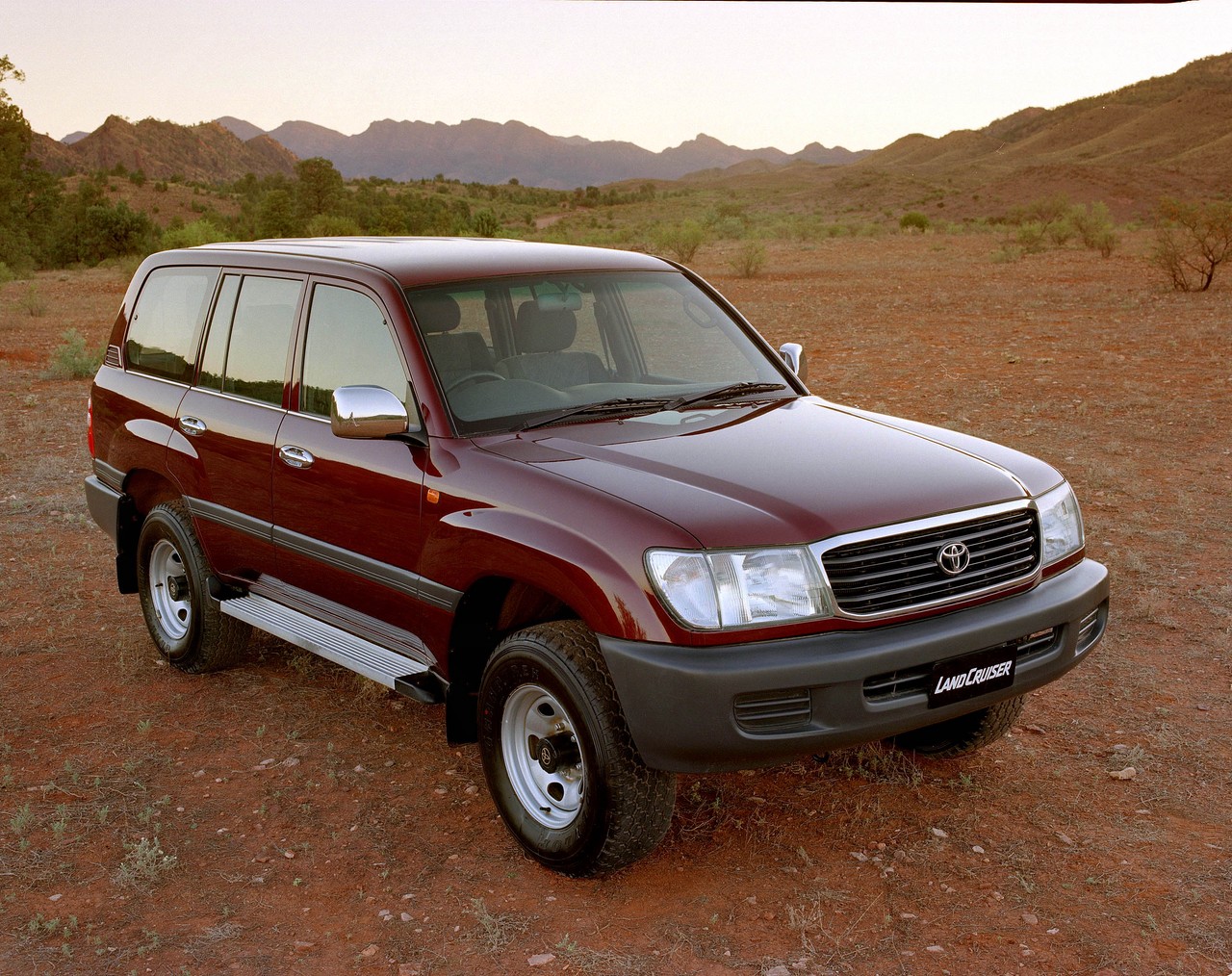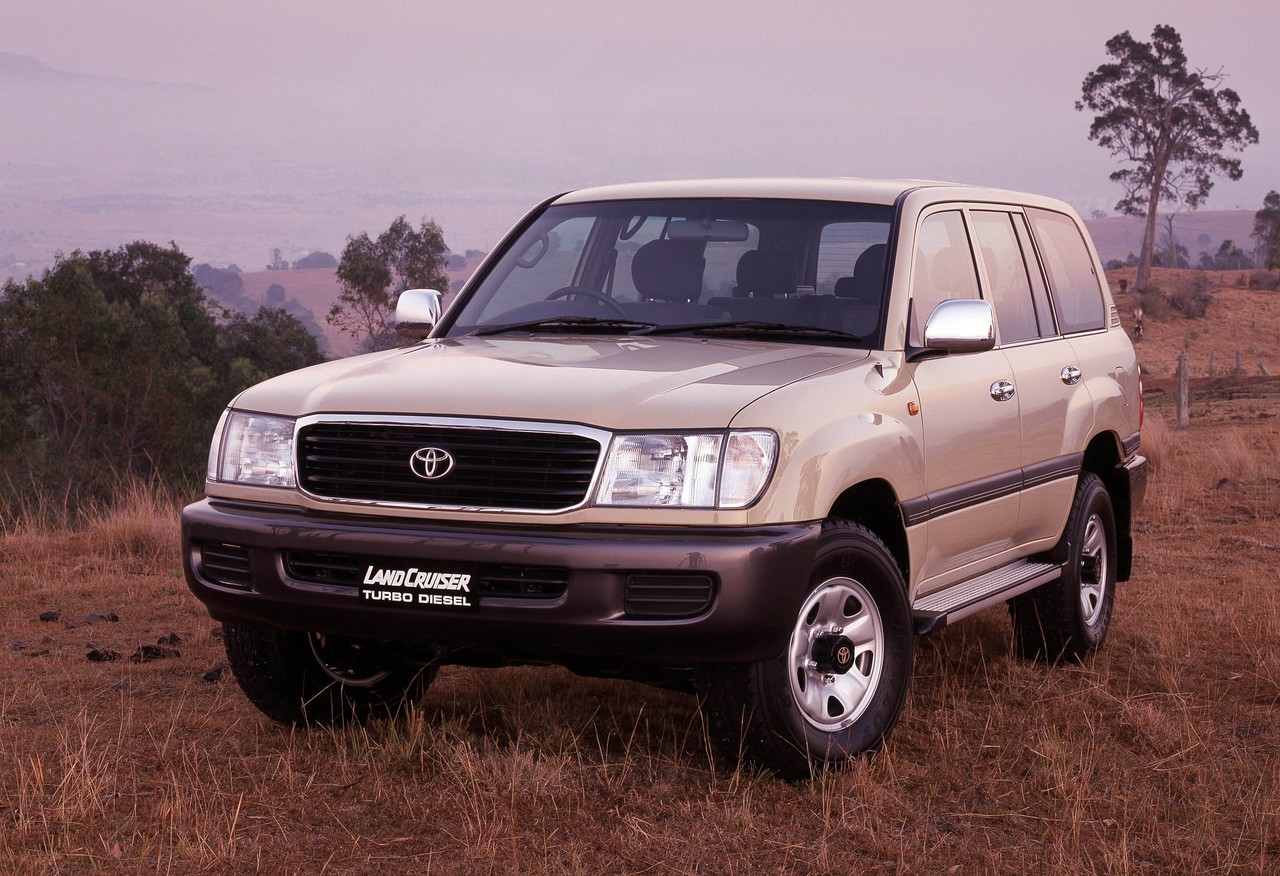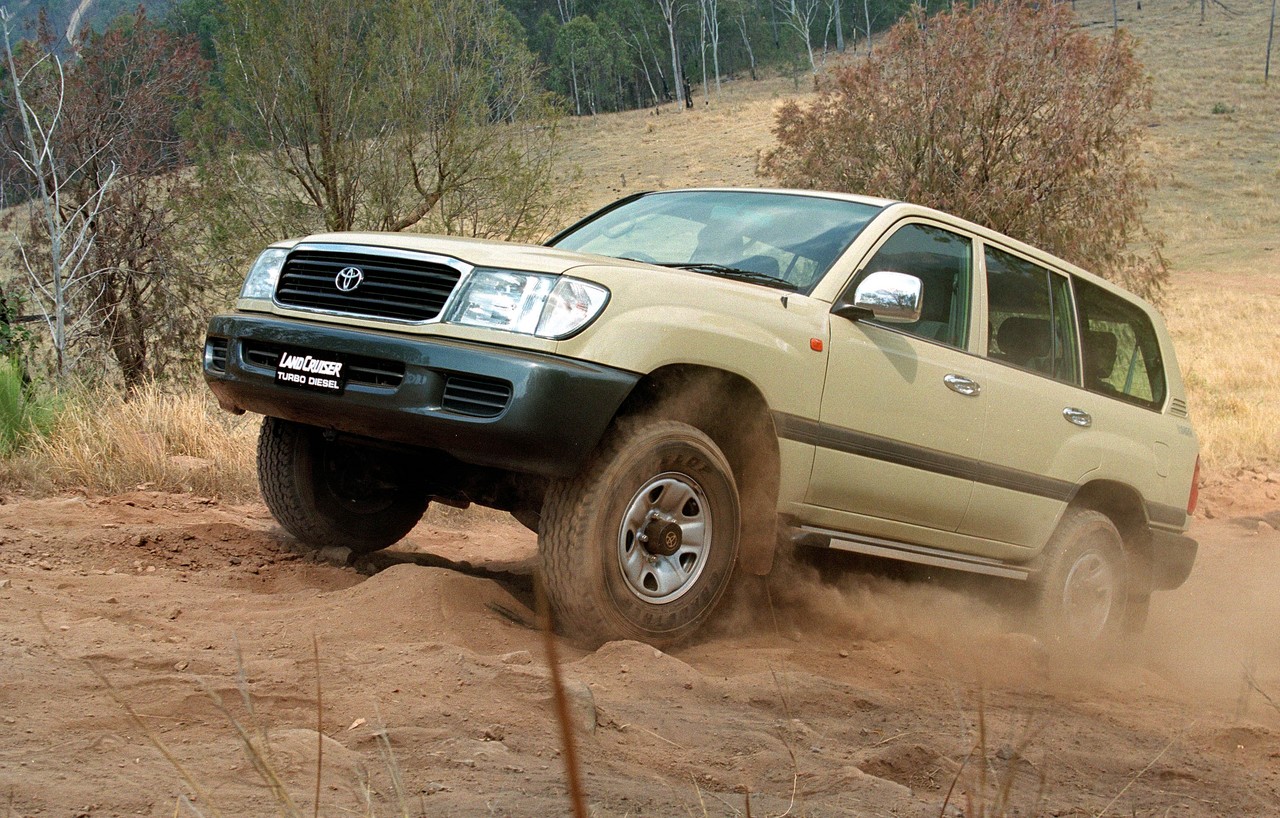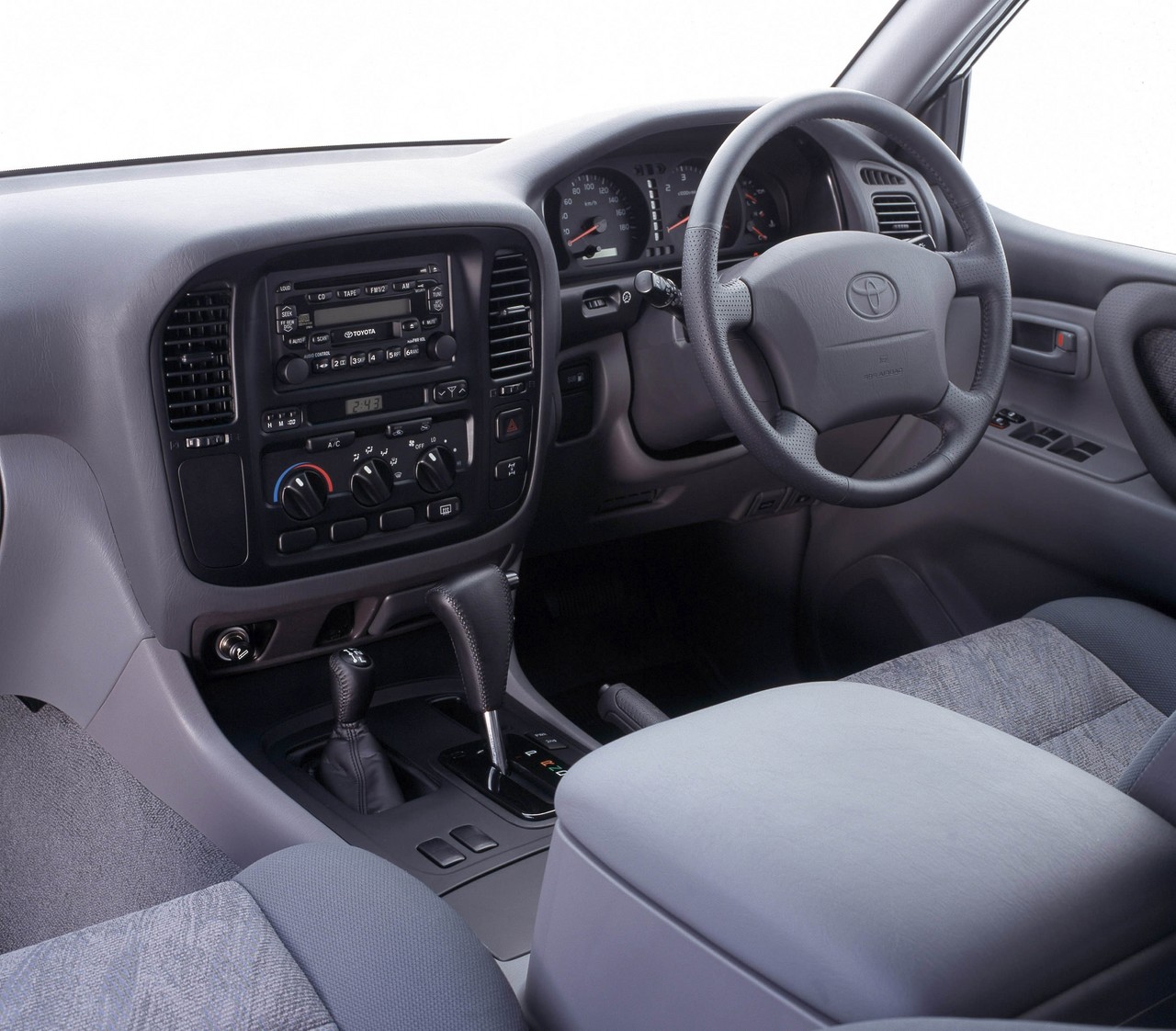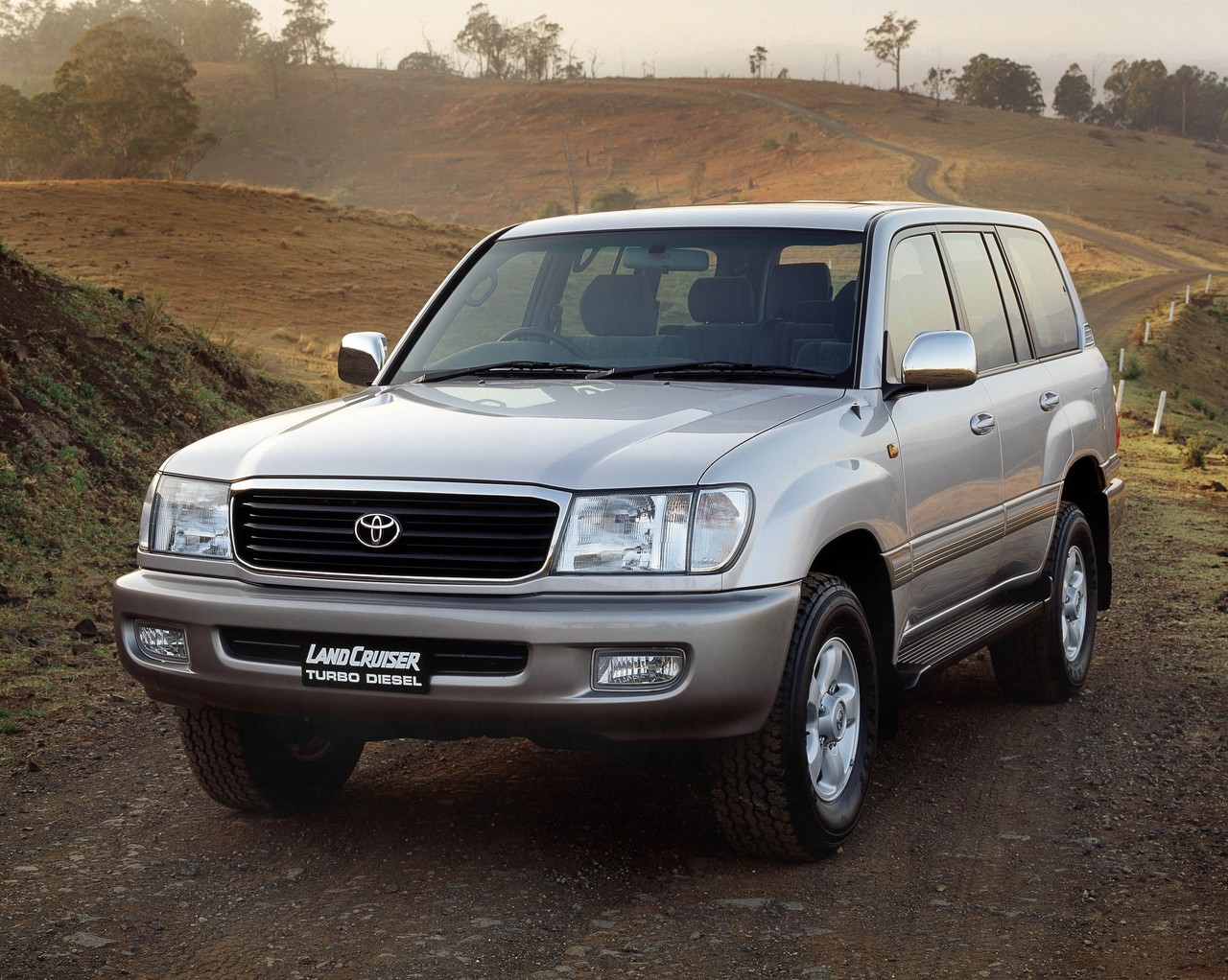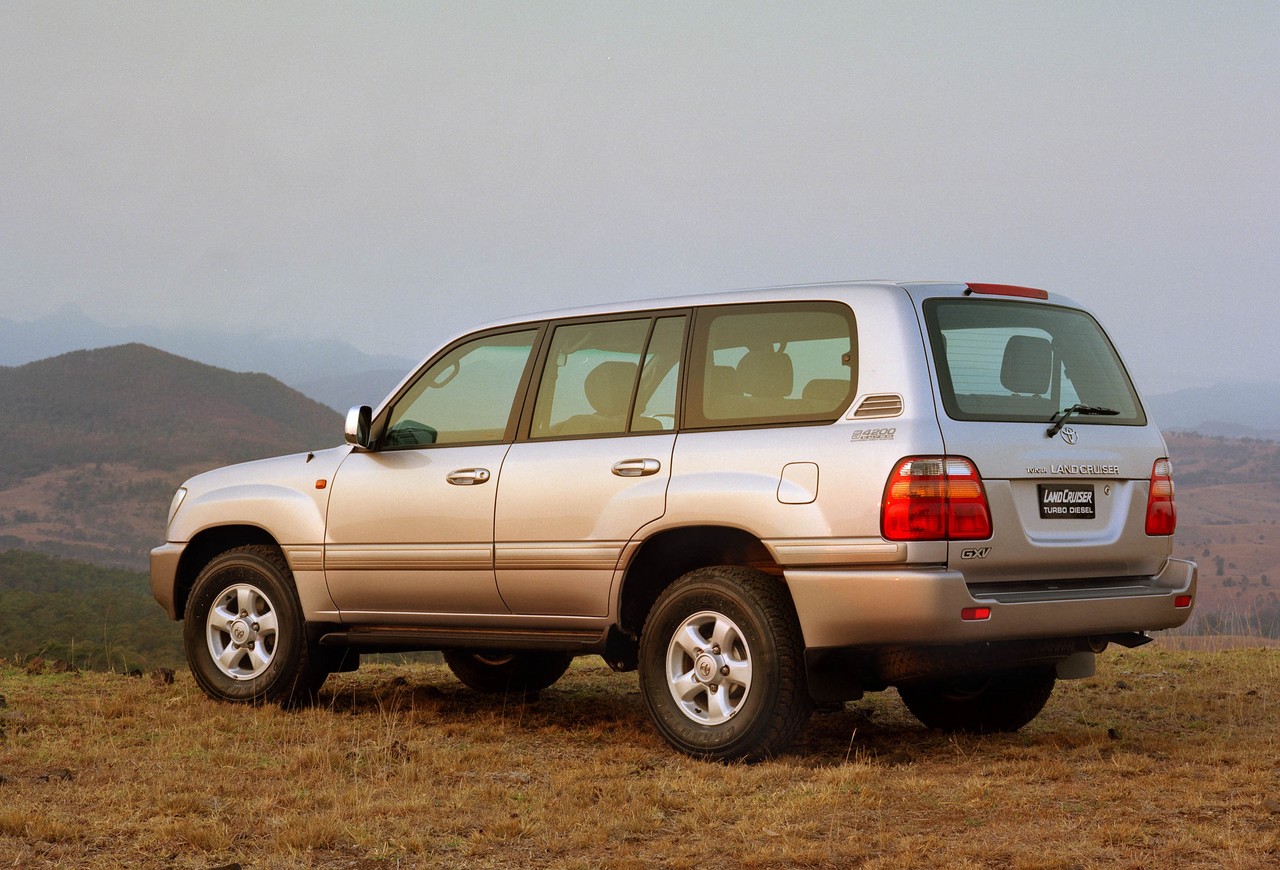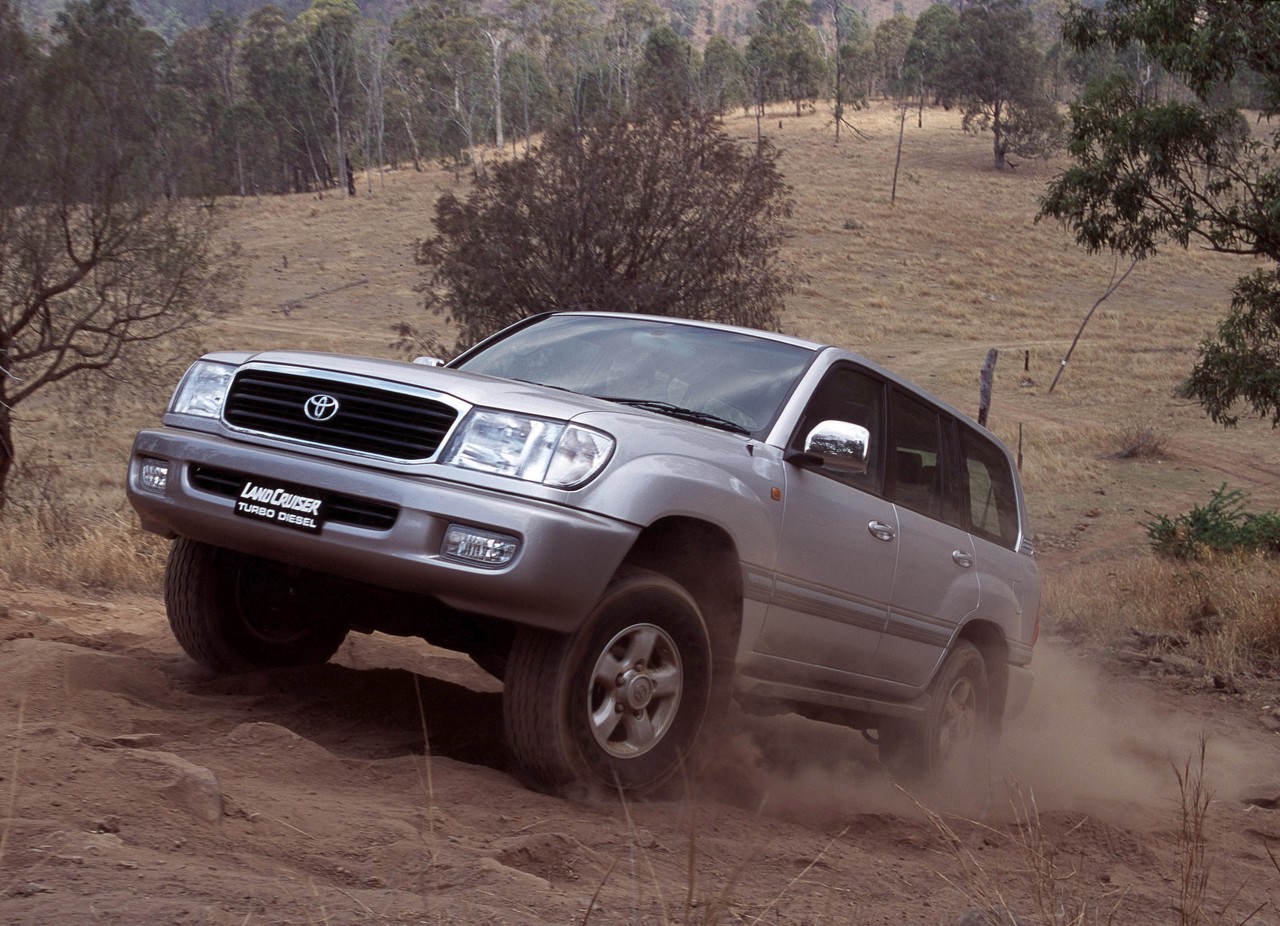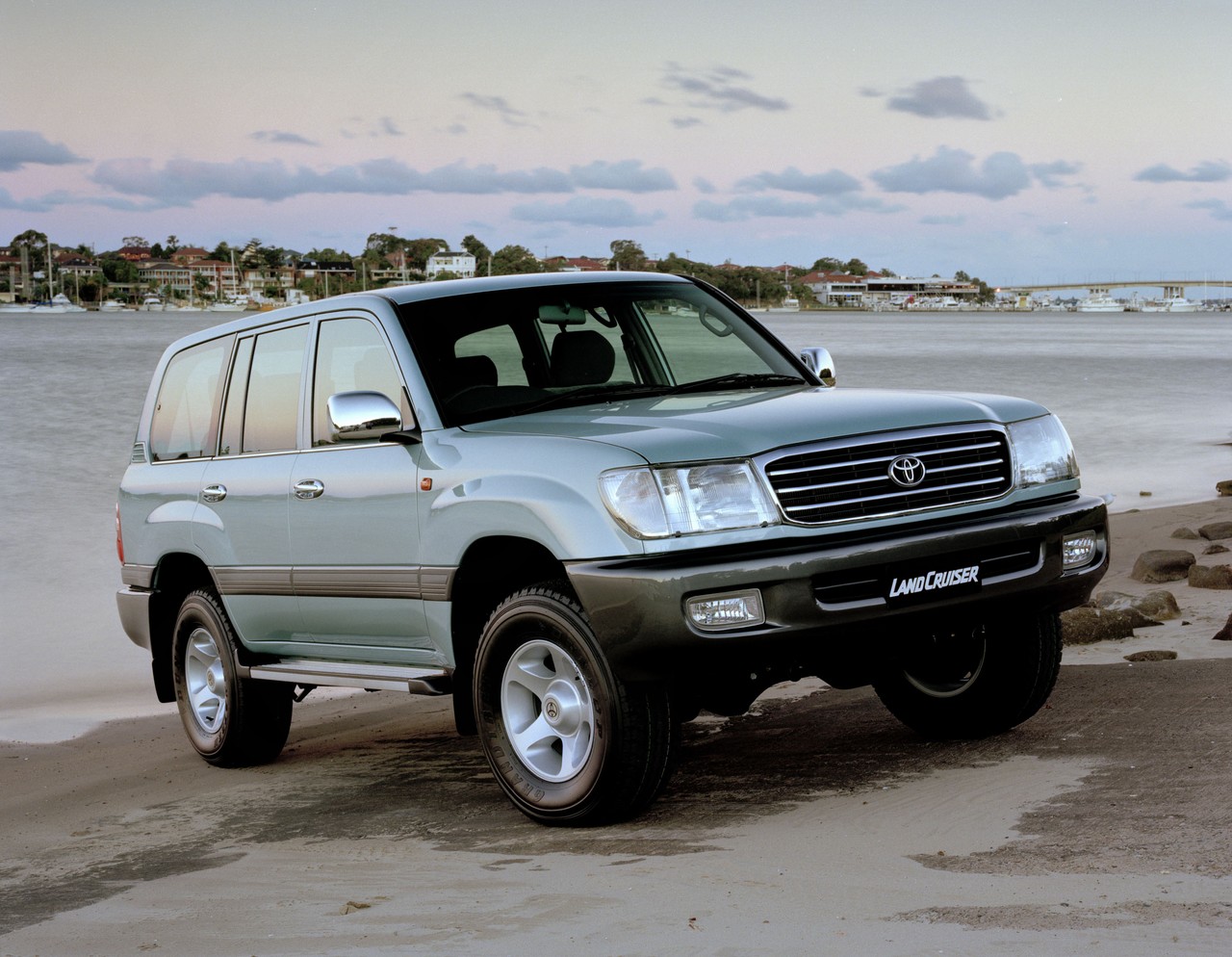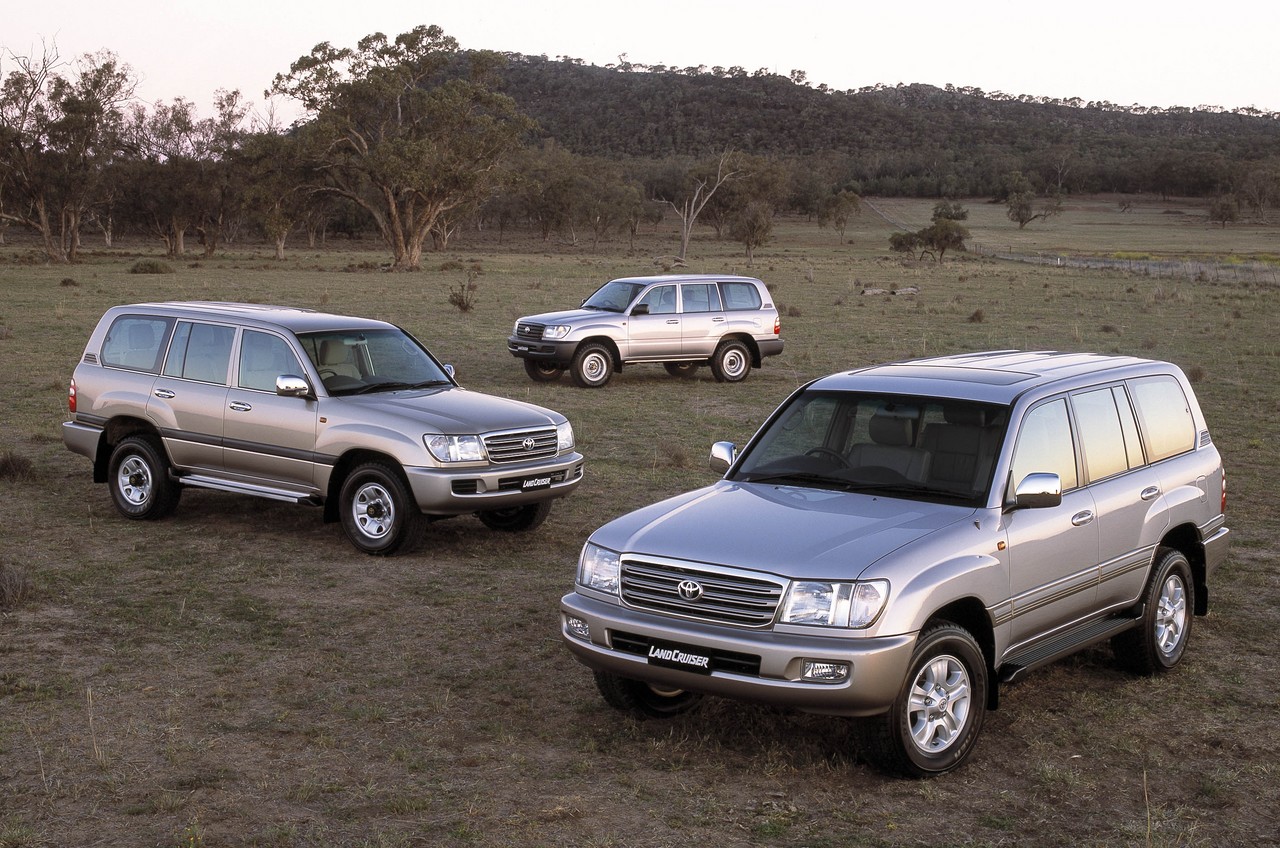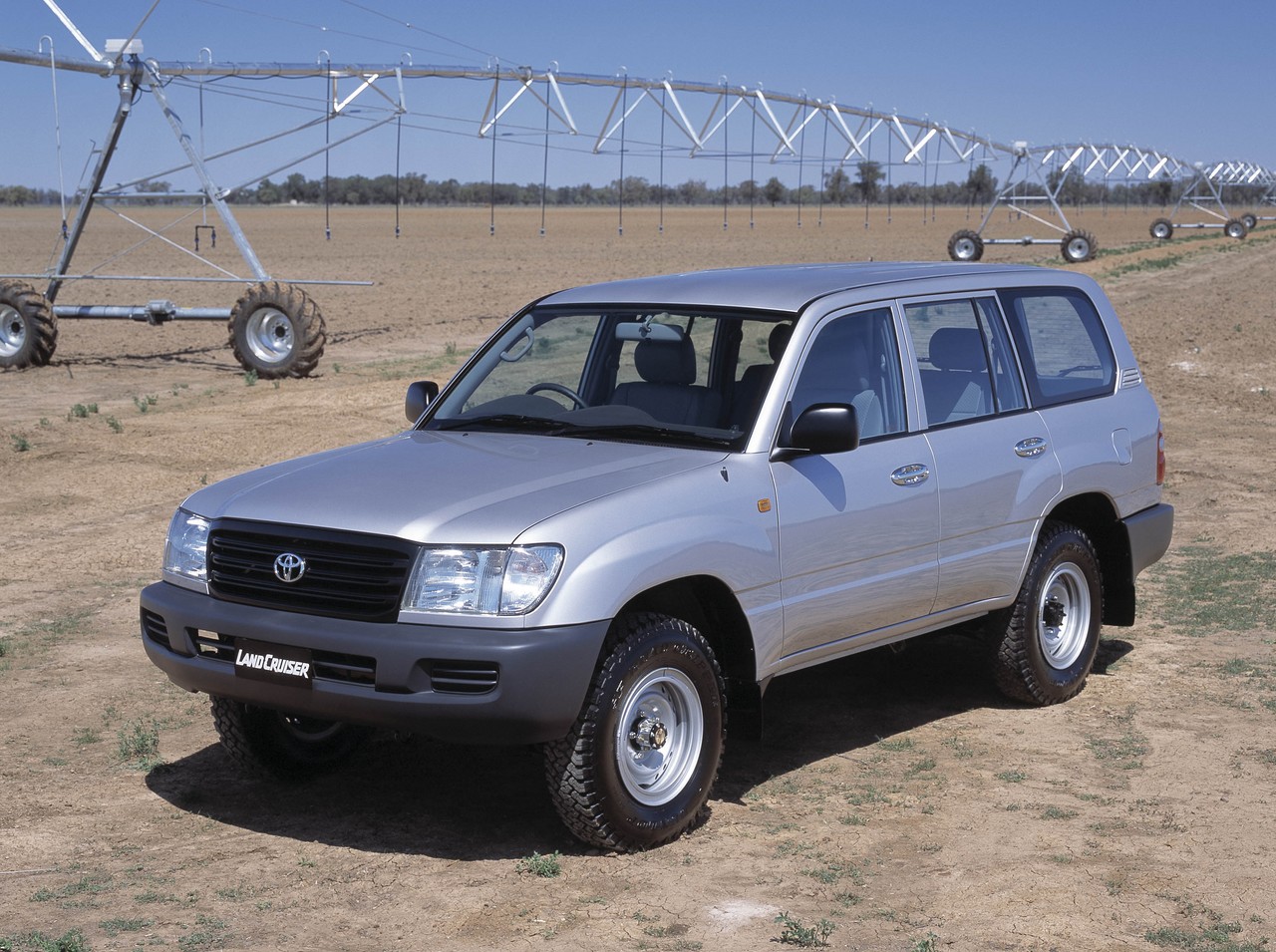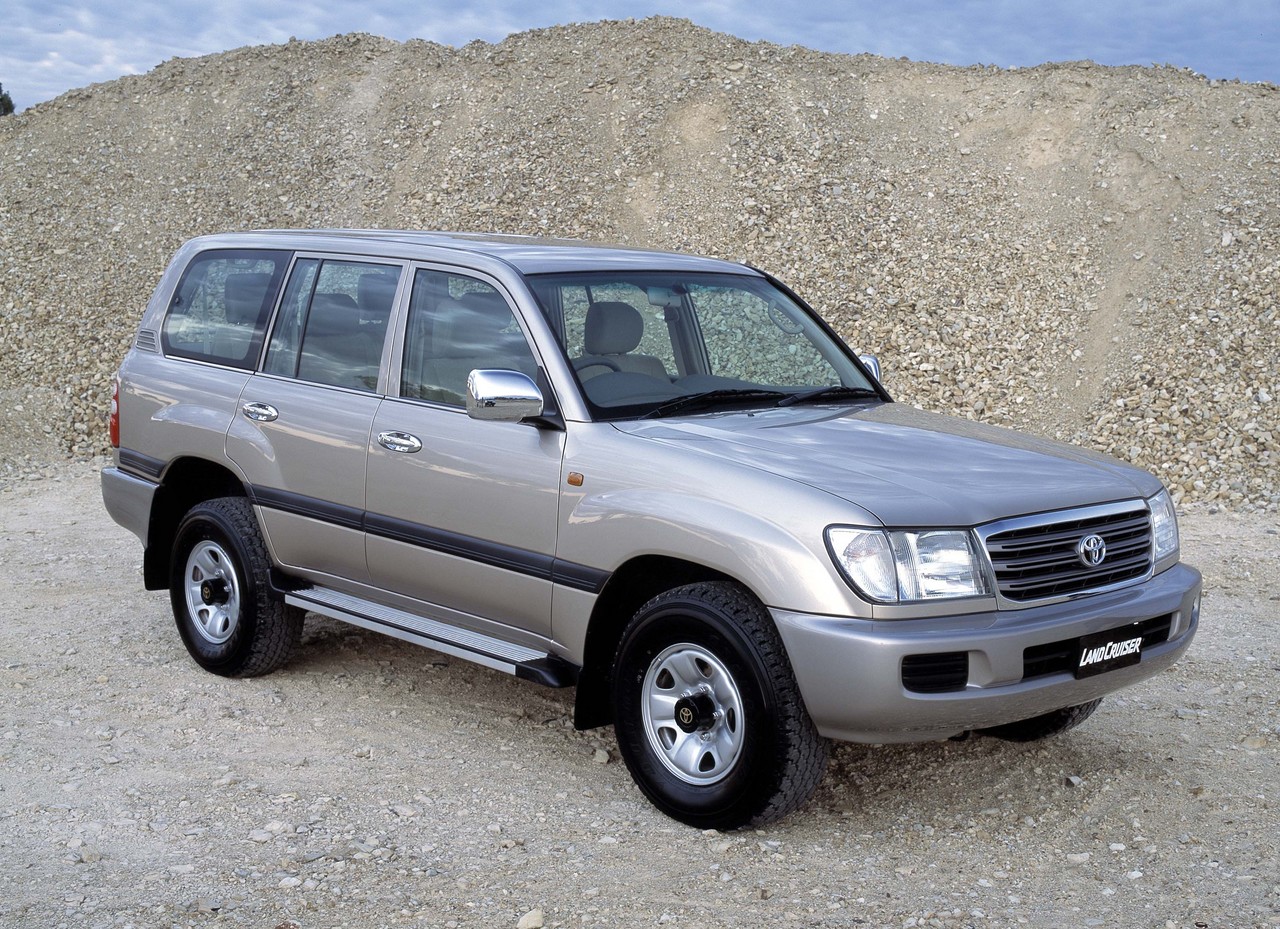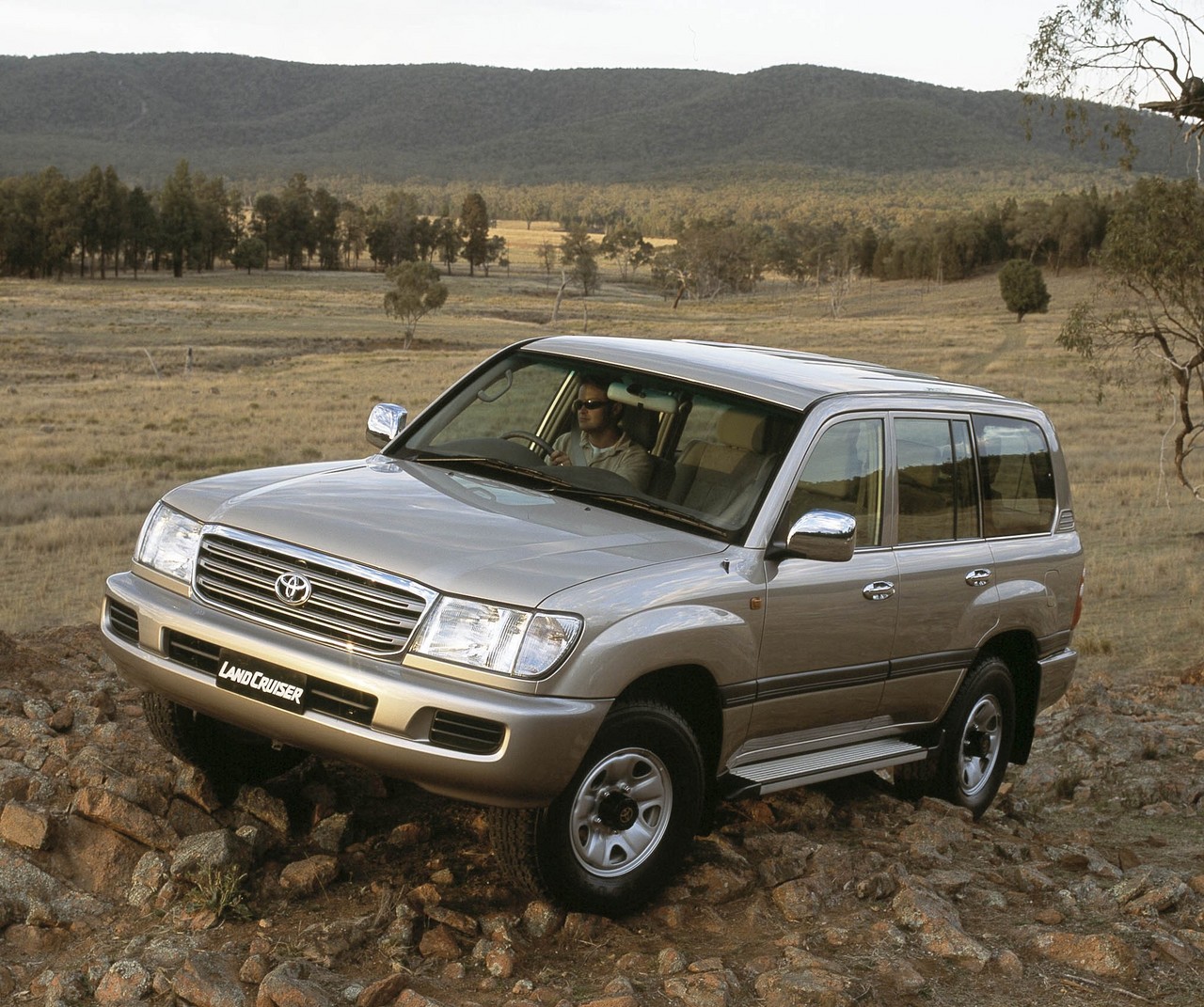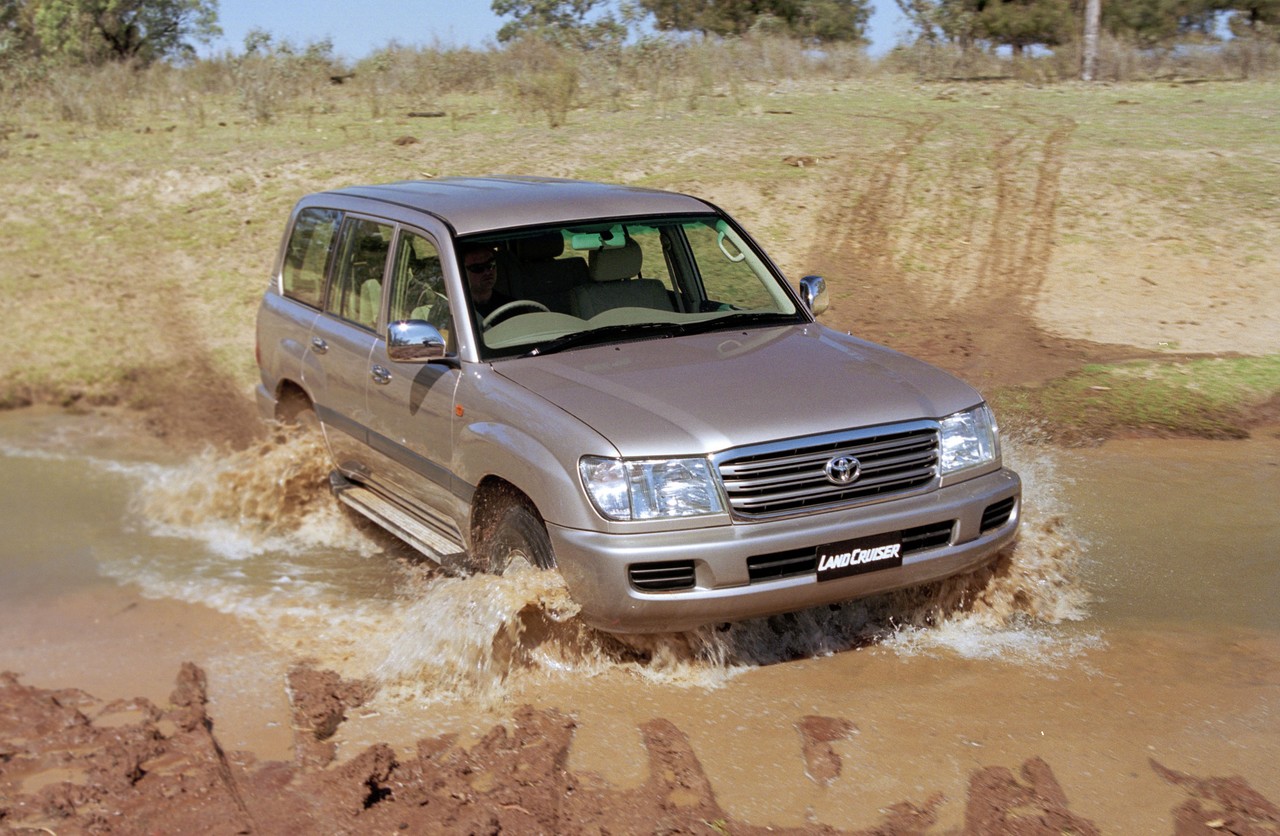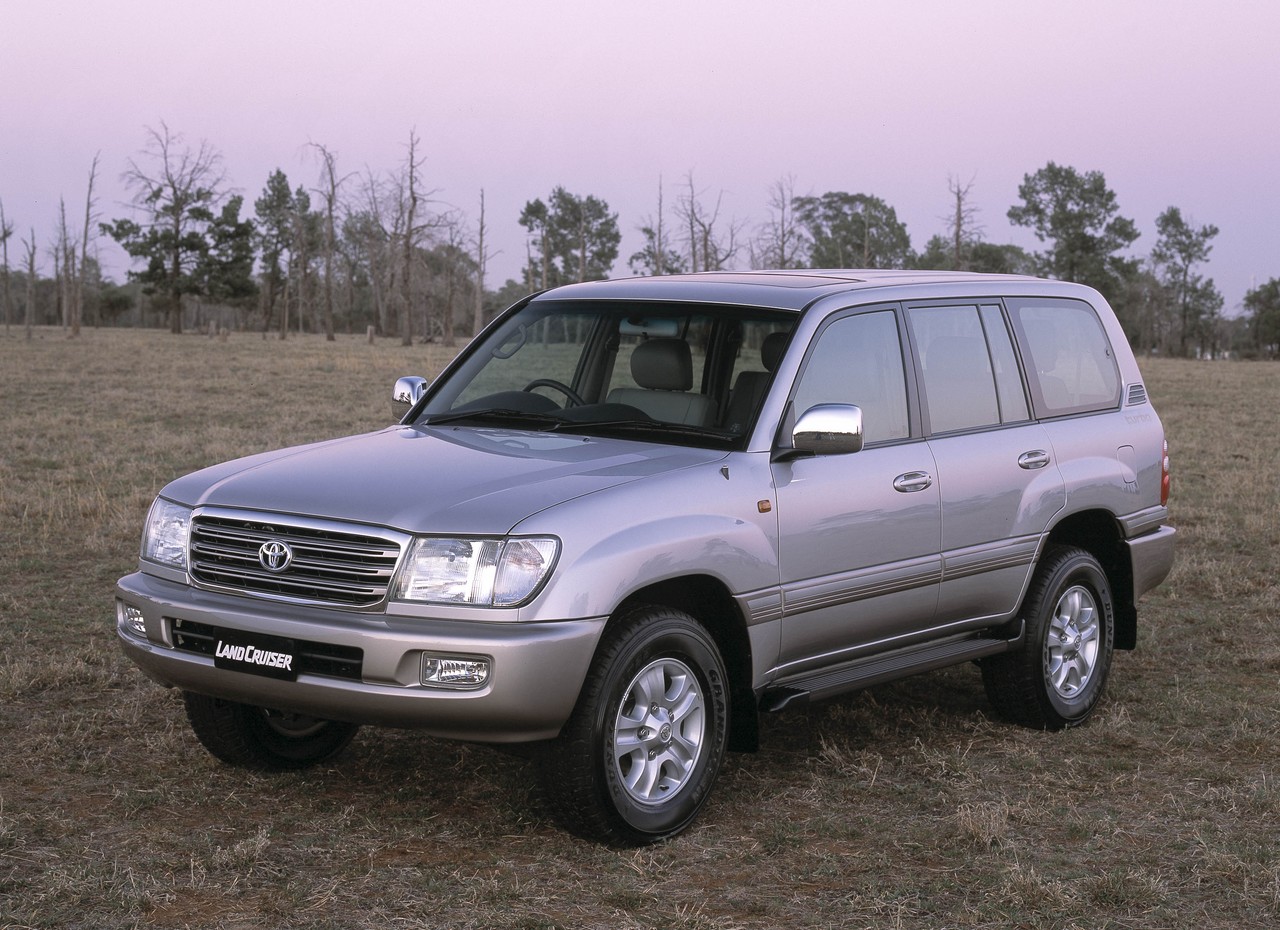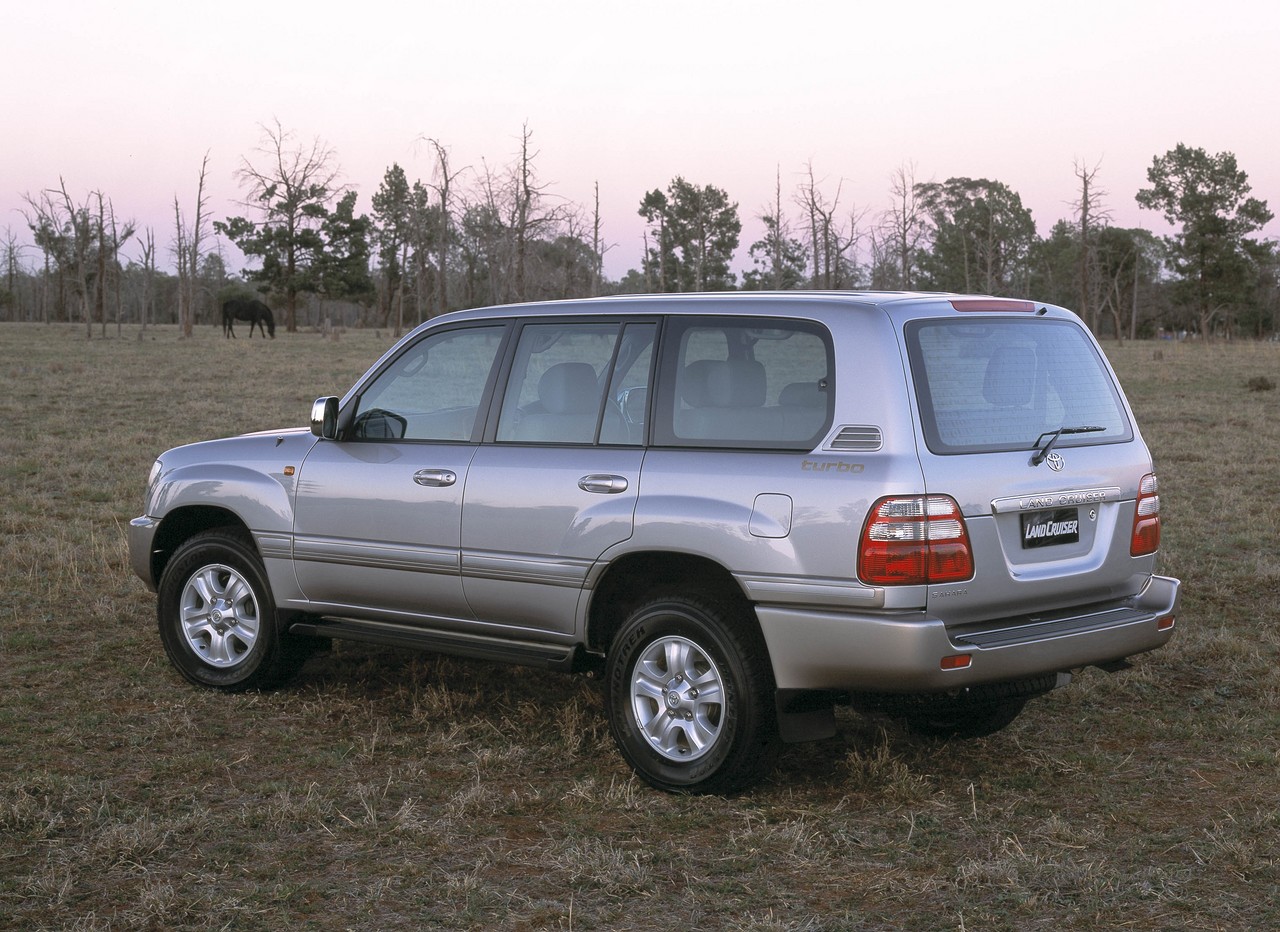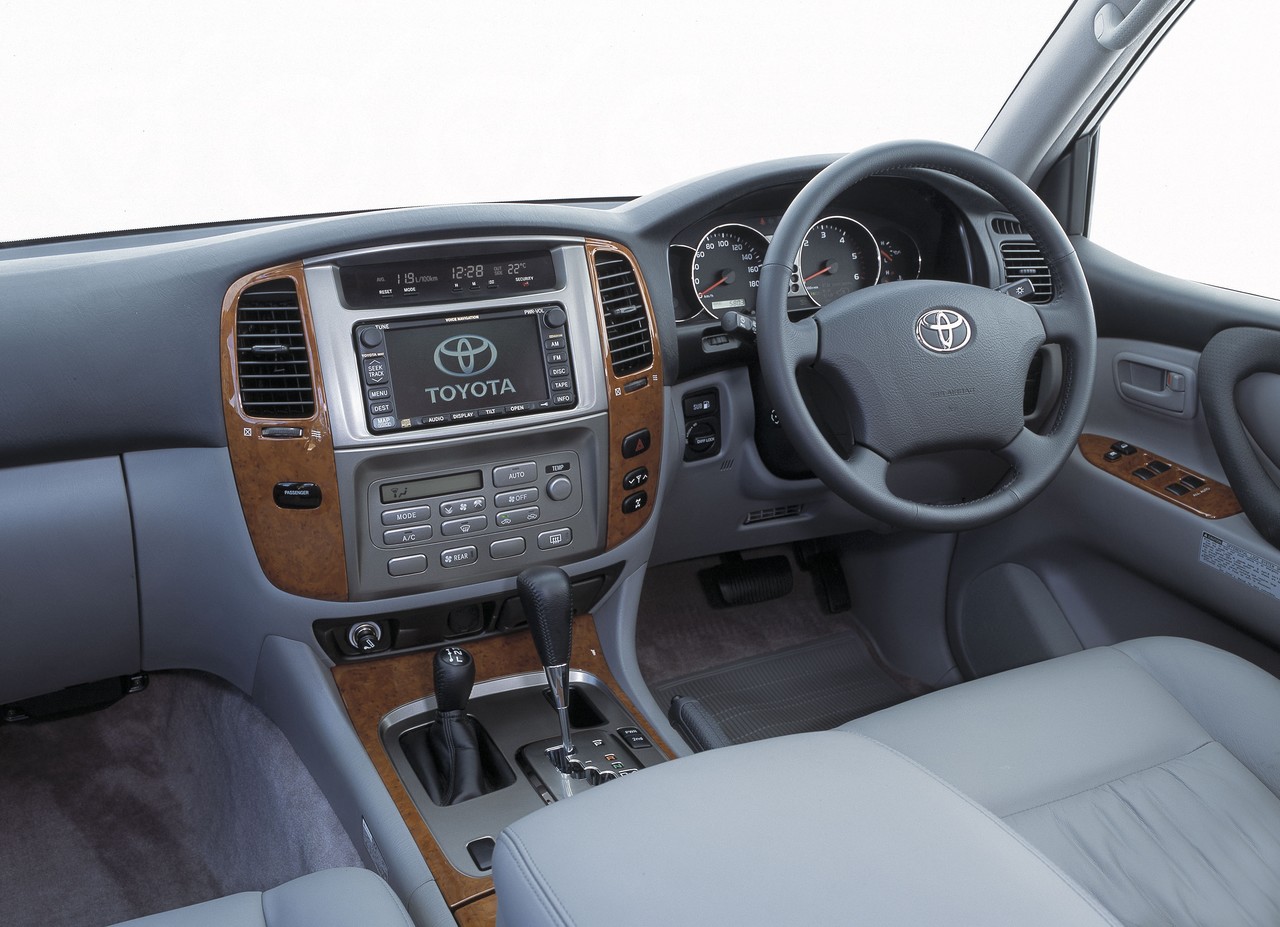
- Refined 4.7-litre 2UZ-FE V8 petrol engine
- Responsive 4.2-litre 1HD-FTE turbo-diesel engine
- For 100-Series LandCruiser, comfortable ride
- Spacious interior
- Off-road capability
- Remote steering feel
- Body roll when cornering
- High fuel consumption for petrol engines
Review: Toyota 100-I Landcruiser (1998-02)
Overview
Released in March 1998, the Toyota 100-Series LandCruiser included both the 105-Series and 100-Series LandCruiser models. The 105-Series carried over chassis and powertrains from the 80-Series LandCruiser with coil-suspended solid axles (front and rear) and inline six cylinder petrol and diesel engines (though the 4.2-litre turbo-diesel was a 100-Series vehicle). As such, the 105-Series models were better suited to off-road use. The 100 Series, however, had a wider chassis, independent front suspension (with double wishbones, hydraulic dampers and an anti-roll bar), new engines and rack and pinion power-assisted steering.
The entry-level Standard variant had six seats (with two rows of three) and vertical barn-type rear doors. The RV, GXL and GXV variants, however, had eight seats across three rows and a conventional rear door. Engine choices initially consisted of a 4.2-litre diesel, a 4.5-litre inline six and a 4.7-litre petrol V8. In October 2000, however, a 4.2-litre six cylinder turbo-diesel engine was introduced. The full range is given in the table below.
Engines
For the 100-Series LandCruiser,
- The 4.2-litre 1HD-FTE inline six-cylinder turbo-diesel engine had a cast iron block and cylinder head, direct injection, an intercooler, single overhead camshaft, four valves per cylinder and a compression ratio of 18.8:1; and,
- The 4.7-litre 2UZ-FE V8 petrol engine had a cast iron block, an aluminium alloy cylinder head, multi-point fuel injection, double overhead camshafts per cylinder bank (belt-driven), four valves per cylinder, bucket tappets and a compression ratio of 9.6:1.
For the 105-Series LandCruiser,
- The 4.2-litre 1HZ six-cylinder diesel engine had a cast iron block and cylinder head, indirect injection, a single overhead camshaft, two valves per cylinder and a compression ratio of 22.4:1; and,
- The 4.5-litre 1FZ-FE six-cylinder petrol engine had a cast iron block, an aluminium alloy cylinder head, double overhead camshafts, four valves per cylinder and a compression ratio of 9.0:1.
| Series | Engine | Variant | Trans. | Years | Peak power | Peak torque |
|---|---|---|---|---|---|---|
| 105 Series (HZJ105) |
4.2-litre diesel I6 (1HZ) | Standard | 5sp man. | 1998-02 | 96 kW at 3800 rpm | 285 Nm at 2200 rpm |
| RV | 5sp man. | 1998-02 | ||||
| 4sp auto | 1998-00 | |||||
| GXL | 5sp man., 4sp auto |
1998-02 | ||||
| 105 Series (FZJ105) |
4.5-litre petrol I6 (1FZ-FE) | Standard | 5sp man. | 1998-00 | 165 kW at 4600 rpm | 387 Nm at 3600 rpm |
| RV | 5sp man. | 1998-02 | ||||
| 4sp auto | 1998-00 | |||||
| GXL | 5sp man., 4sp auto |
1998-02 | ||||
| 100 Series (HDJ100) |
4.2-litre turbo-diesel I6 (1HD-FTE) | GXL, GXV |
5sp man., 4sp auto |
2000-02 | 151 kW at 3400 rpm | 430 Nm at 1400-3200 rpm |
| 100 Series (UZJ100) |
4.7-litre petrol V8 (2UZ-FE) | GXV | 4sp auto | 1998-00 | 170 kW at 4800 rpm | 410 Nm at 3400 rpm |
Dimensions
The 100- and 105-Series LandCruisers were 4890 mm long, 1940 mm wide, 1890 mm tall and had 2850 mm long wheelbases.
Suspension
The 100-Series LandCruiser had independent, double wishbone front suspension with a torsion bar, telescopic gas-pressurised hydraulic dampers and a stabiliser bar. Furthermore, the live rear axle had five-links, coil springs, gas-pressurised dampers, a panhard rod and stabiliser bar.
The 105-Series LandCruiser had a live front axle with three links, coil springs, telescopic gas-pressurised hydraulic dampers and a stabiliser bar. Furthermore, the live rear axle had five links, gas-pressurised hydraulic dampers, a panhard rod and stabiliser bar.
4WD system
The four-wheel drive (4WD) system for the Toyota LandCruiser included a two-speed transfer case, centre differential and limited slip rear differential. While the Standard variant had a part-time 4WD system with manually locking, free wheeling hubs, all other variants had permanent 4WD.
Safety equipment
Standard safety equipment for the Toyota 100- and 105-Series LandCruiser included front outboard seatbelt pretensioners. The LandCruiser GXL and RV variants were further equipped with dual front airbags, ABS and load limiting front seatbelts. All models were fitted with four-piston front brake calipers.
From November 1999, the LandCruiser GXV was further equipped with electronic stability control, traction control, electronic brake force distribution and brake assist. As a result of the introduction of the four-wheel drive traction control, a rear differential lock was no longer fitted.
Features: Standard, RV, GXL and GXV
Features for the LandCruiser Standard included a two speaker sound system with radio and cassette player, a tilt adjustable steering column, two 12 volt power outlets and an immobiliser.
The LandCruiser RV was further equipped with four speaker sound system, central locking and power mirrors. Beyond this, the LandCruiser GXL added a CD player, remote central locking, power windows and side steps.
The range-topping LandCruiser GXV was distinguished by its 16-inch alloy wheels, six-disc CD stacker, climate control air conditioning, velour upholstery, cruise control and leather-wrapped steering wheel and gear knob. From November 1999, the GXV also featured dual-zone climate control conditioning and front fog lights.
October 2000: LandCruiser update
In October 2000, there was a minor update to coincide with the introduction of turbo-diesel engines:
- Standard variants were fitted with a two-tone dashboard and child locks for the rear barn doors;
- Non-Standard variants received a small storage box in the front console; and,
- The GXL was fitted with contrasting painted bumpers.
Furthermore, all turbo-diesel models were fitted with dual batteries for increased reliability.
1999 LandCruiser Snowy
In June 1999, a limited-run Snowy variant was released to commemorate the 50th anniversary of the Snowy Mountains Hydro-Electric scheme. Compared to the GXL, the Snowy variant added 16-inch alloy wheels, a six-disc CD stacker and velour trim.
2001 LandCruiser 50th Anniversary
In July 2001, a limited-run 50th Anniversary variant was released. Based on the GXL, the 50th Anniversary featured 16-inch alloy wheels, a six-disc CD stacker, air conditioning, velour seat trim, front fog lights, a height adjustable driver’s seat and floor mats. Visually, the 50th Anniversary variants could be identified by their chrome radiator grilles, head light covers and ’50th Anniversary’ badges.
2002 LandCruiser Advantage Limited Edition
In May 2002, an ‘Advantage Limited Edition’ variant was released. Based on the GXL, the Advantage Limited Edition was differentiated by its 16-inch alloy wheels, air conditioning, velour seat trim, cruise control, height adjustable driver’s seat with powered lumbar support, adjustable front head rests, illuminated vanity mirror and courtesy lamps. Visually, the Advantage Limited Edition could be identified by its unique radiator grille, windshield glass top shade band and large side protection moulding.
Related links
- Press Release: Toyota 100-I Landcruiser GXV upgrades (November 1999)
- Press Kit: Toyota 90-II LandCruiser Prado and 100-I LandCruiser with Turbo-diesel engines (October 2000)
- Press Release: Toyota 100-I LandCruiser 50th Anniversary (July 2001)
- Press Release: Toyota 100-I LandCruiser Advantage Limited Edition (May 2002)
Review: Toyota 100-II Landcruiser (2002-07)
Overview
Released in October 2002, the Toyota 100-Series Mk.II (100-II) Landcruiser introduced a revised range as the 4.5-litre petrol engines were discontinued and range-topping Sahara variants and five-speed automatic transmissions were introduced. Standard safety equipment and features were also upgraded.
Mechanical upgrades for the naturally aspirated diesel engine included an exhaust gas recirculation system and a timing control valve for the fuel injection pump to reduce nitrogen emissions; the turbo-diesel engines were also fitted with lead-free intake valve seats and a drain line for the intercooler so that oil could be extracted in the event of an emergency.
| Series | Engine | Variant | Trans. | Years | Peak power | Peak torque |
|---|---|---|---|---|---|---|
| 105 Series (HZJ105) |
4.2-litre diesel I6 (1HZ) | Standard, GXL |
5sp man. | 2002-07 | 96 kW at 3800 rpm | 285 Nm at 2200 rpm |
| 100 Series (HDJ100) |
4.2-litre turbo-diesel I6 (1HD-FTE) | GXL | 5sp man., 4sp auto |
2002-07 | 151 kW at 3400 rpm | 430 Nm at 1400-3200 rpm |
| VX | 5sp auto | 2006-07 | ||||
| Sahara | 5sp auto | 2002-07 | ||||
| 100 Series (UZJ100) |
4.7-litre petrol V8 (2UZ-FE) | GXL | 5sp man., 5sp auto |
2002-07 | 170 kW at 4800 rpm | 410 Nm at 3400 rpm |
| VX | 5sp auto | 2006-07 | ||||
| Sahara | 5sp auto | 2002-07 |
Safety equipment
Safety equipment for the LandCruiser Standard included dual front airbags and front seatbelt pretensioners. Beyond this, the LandCruiser GXL added ABS, while the VX and Sahara were further equipped with electronic stability control and traction control.
Features: Standard, GXL, VX and Sahara
Features for the LandCruiser Standard included a two speaker sound system with radio and cassette player, tilt adjustable steering column, two 12 volt power outlets and an immobiliser.
The LandCruiser GXL was further equipped with a four speaker sound system with a six-disc CD player, air conditioning, cruise control, remote central locking, power windows, power mirrors and side steps. Beyond this, the VX added 17-inch alloy wheels, power adjustable front seats, leather trim, a power sunroof and adjustable front seat head restraints.
The range-topping LandCruiser Sahara was differentiated by its dual-zone climate control air conditioning, touch screen satellite navigation, front fog lights, cooled compartment in the centre console, trip computer and woodgrain interior trim.
August and September 2005: LandCruiser updates
In August and September 2005, the 100-II LandCruiser was updated. The Sahara variant was fitted with variable gear-ratio steering (i.e. speed-sensitive steering), an upgraded satellite navigation unit, Optitron instrumentation and UV-cut privacy glass for the side and rear windows. Furthermore, the Sahara was also equipped with:
- Toyota’s Electronically Modulated Suspension (‘TEMS’) which controlled the damping forces of the shock absorbers for semi-active roll control; and,
- Active Height Control (AHC), which provided 50 mm variable ride height and automatic vehicle levelling for greater ride comfort. AHC was controlled by a switch with ‘Off’, ‘Normal’, ‘Lo’ and ‘Hi’ settings, though the ride heights could be overridden if certain parameters were exceeded.
From September 2005, the Standard and GXL variants also received improved interior lighting and a height adjustable driver’s seat. The GXL was also fitted with new 17-inch five-spoke alloy wheels, rear air conditioning and driver’s seat power lumbar adjustment.
These updated models could be identified by their new front mask with twin-pocket design headlights (including clearance lamps built in the low-beam pocket), a more pronounced radiator grille with three horizontal bars and faster-illuminating LED brake lights.
2004 LandCruiser Kakadu
In May 2004, the limited-run LandCruiser Kakadu was released. Based on the GXL variant, the LandCruiser Kakadu was differentiated by its 17-inch alloy wheels, leather seat and door trim, power adjustable front seats, rear air conditioning, centre console cool box, power tilt and telescopic steering wheel adjustment and ‘Kakadu’ decal.
Related links
- Press Kit: Toyota 100-II LandCruiser (October 2002)
- Press Release: Toyota 100-II Landcruiser rear seat entertainment (RSE) system (August 2003)
- Press Release: Toyota 100-II Landcruiser Kakadu (May 2004)
- Press Release: Toyota 100-II Landcruiser Kakadu (October 2004)
- Press Kit: Toyota 100-II LandCruiser Sahara update (August 2005)
- Press Release: Toyota 100-II LandCruiser GXL upgrades (September 2005)
- Press Release: Toyota 100-II LandCruiser VX (April 2006)
- Wikipedia.org: Toyota 100 Landcruiser
